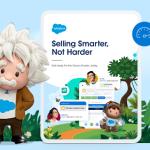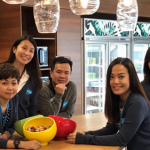If 2020 was a year of turbulence for commerce, the future of commerce is all about momentum.
The mass acceleration to digital has changed the customer experience forever, providing more channels, choices, and flexibility. But each new offering sets the customer expectation bar a little higher, increasing the pressure on companies to deliver more at a faster pace.
To help teams prepare for what’s ahead, Lidiane Jones, Salesforce’s executive vice president and general manager of Commerce Cloud, offers her perspective on the future of commerce.
How has commerce changed over the last year?
Our customers are turning away from traditional channel planning and embracing a digital-first approach that brings more flexibility. Digital is also leading our customers to use their physical spaces in more intentional ways. In automotive, for example, dealers can know a lot about customers who research vehicles online before they ever walk through the door.
As I mentioned at Dreamforce 2021, digital transformation is here to stay and commerce teams are betting on customer-centric experiences throughout all of it. Even B2B sellers are trying to understand the end user of their products. That’s not just to develop a better relationship with buyers, but to understand the feedback from their customers’ customers.
The key to all of this is data. More and more, companies are looking for full ownership of their data to get true insight into what shoppers or buyers want.
How can brands take the buying experience to the next level in 2022?
I recommend that brands step back, figure out their unique value proposition, and then apply the right strategy that will capture customers and keep them coming back for more.
Building a great customer loyalty program is an important trend, but the approach depends on the brand. For some companies, sustainability is important. Their customers want to know if the brand is socially responsible. In other cases, it is about promotions or other financial incentives. It can also be about personalised experiences or social connections, like what brands a shopper’s friends are considering.
That could be a very different approach for some brands. How are teams preparing for the future of commerce?
Our Commerce Cloud customers talk a lot about choice and flexibility, which is something a full headless commerce implementation offers. More and more, commerce teams are moving away from traditional architectures and choosing headless because it gives them the freedom to be agile and deliver compelling experiences faster across any kind of engagement channel, from social to mobile. Over the last 12-18 months we’ve focused on building the tools our Trailblazers need to build a connected experience where data is at the centre of everything.
Creating those highly personalised experiences across the customer journey can be really challenging. So, we are excited to give our customers the chance to deliver the most complex interactions with Salesforce CDP.
Speaking of planning, we’re getting close to the holiday shopping season. How can brands prepare for spikes in demand?
Profitability during peak shopping periods is all about preparation. Two things are top of mind for our customers. First, when you hit that peak demand, you’re wondering, “Will I have enough products? Will I have the right inventory to fulfill those needs?” You never want to be over or under. You want to be as close to what your demand is as possible, so having the data and tools to plan is essential.
The second thing is, “Am I going to be able to deliver in time for the customer’s needs?”
A lot of shoppers wait until the last minute to order. With our location-based inventory capabilities, our focus has really been anchored to helping customers plan inventory effectively. They need to be prepared for what their demand is going to be and then optimise delivery times so they can meet consumer expectations in a cost effective way.
Beyond retail, what online buying trends do you see next year for other industries?
If you want to sell digitally with confidence, you have to be as immersive as possible. That’s why we’re seeing an incredible acceleration in emerging technologies. In automotive and manufacturing, we’re seeing a huge adoption of 3D virtual reality (VR) capabilities to help people research what they want to buy. Video selling for furniture is another example. You actually want to talk to someone before you buy a very expensive piece of furniture.
Another fast-growing trend is the innovation across payments. If you are trying to buy a product that’s really expensive, or if you’re making a large B2B purchase, you want more flexibility in your cloud cash flow. Giving customers new payment options is a smart way to build repeat business and customer loyalty.
Speaking of social responsibility, how can brands become more sustainable and use this as a competitive advantage?
We have the responsibility and the opportunity to build businesses that are more sustainable. Net Zero Cloud gives companies a better view of how sustainably they’re running their businesses.
Commerce teams specifically worry about keeping waste to a minimum. A waste of inventory is a waste of resources. It’s more than a matter of financial hardship. We’re excited to create opportunities for environmentally conscious brands that want to adapt their business models to operate more sustainably.
The trend in retail, for example, is to buy products back and resell them. Some brands have customers who are really passionate about this. It’s become a great revenue source. But more importantly, it’s an embedded strategy that supports sustainability in a genuine way.
Salesforce Commerce Cloud empowers you to create seamless ecommerce experiences that inspire and convert today’s connected shoppers. Learn more about Commerce Cloud.
This post originally appeared on the US-version of the Salesforce blog.

























